Apple iPad Pro M1 12.9 review: Powerful, but what’s the power for?
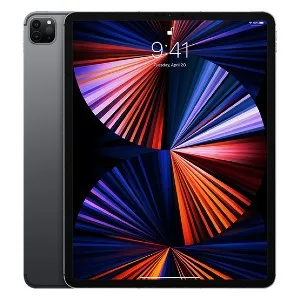
Summary
Quick verdict: The Apple iPad Pro M1 12.9 is the fastest iPad Apple’s ever made, and its mini-LED screen makes it a joy to look at too. The use of the M1 processor does still leave Apple’s Pro-level tablet with more power than it knows what to do with, however.
- M1 is insanely powerful
- Gorgeous display
- 5G connectivity options
- Still only one connection port
- Worth comparing your MacBook options at this price
- It costs how much? Oh.
Externally and before you power it on, the Apple iPad Pro M1 12.9 doesn't appear to offer much above the previous generation large-format Apple tablet. However, once you start using it and appreciating both the power of the M1 processor and the incredible contrast of the Liquid Retina XDR display, you'll quickly see why this is a huge jump forward for Apple's tablet ambitions.
However, like any huge jump forward, you need not just momentum but also a defined place to land, and it's still not 100% clear who the ideal target market for the Apple iPad Pro M1 12.9 actually is. It's worth considering your options both in smaller iPads and MacBooks especially if you're in the Apple fold already.
Design
Design
- Slightly thicker than previous generation
- Only two colour choices
- Single Thunderbolt 3/USB-4 port
- Liquid Retina XDR display is stunning
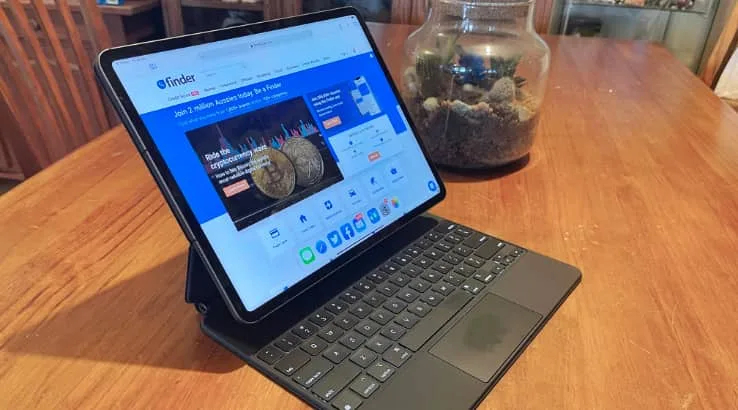
Apple's iPad Pro 12.9 has always been a big beast of a tablet, which is rather inherent when you make a tablet with a 12.9-inch display. However, the Apple iPad Pro M1 12.9 is an even fatter prospect than its predecessors, measuring in at 6.4mm thick, a full 0.5mm over the 2020 iteration. This also means it's heavier than the prior model.
Apple pitches the iPad Pro line as a professional tool – and that's displayed in the choice of colours you can pick from. While it's gone very multi-hued for the recent Apple iMac M1 24-inch, you're stuck with just the standard Space Grey or Silver options in iPad Pro land, whether you opt for the 12.9-inch or 11-inch model.
The big change for the Apple iPad Pro M1 12.9 is an upgrade in screen technology that you don't get on the 11-inch model. It uses an array of mini-LEDs to significantly change the way that screen backlighting works, and naturally, Apple has a silly marketing name for it. Strictly speaking, as the Tim Cook flies, you're looking at a 12.9-inch "Liquid Retina XDR" screen with a resolution of 2,732x2,048 pixels. That's already sharp, but the use of mini-LED means that it packs in some 2,596 local dimming zones behind the screen, giving it considerable scope for high degrees of contrast. Apple's claim is that it has a million-to-one contrast ratio, giving it the kind of "blacker blacks" you typically associate with full high-end OLED TVs. It's a very nice piece of glass when you have proper HDR content to watch or edit on it, although it's really only if you put it side by side with an older iPad – or even the current gen M1 iPad Pro 11-inch – that you'll always pick up the difference.
Otherwise, it's much a case of same old, same old with the Apple iPad Pro M1 12.9's design. You're still perplexingly limited to a single input/output socket, and while Apple's upgraded it so it's Thunderbolt 3/USB-4 compliant, it means that Apple's "Pro" tablet can really only physically talk to the outside world through one cable at a time. This is limiting for the kinds of workflows Apple pitches the iPad Pro 12.9 towards, especially at its hefty price point.
Camera
Camera
- Good cameras for a tablet
- Still super awkward to frame shots
- Portrait mode only works for front-facing lens
- Center Stage is great for meetings
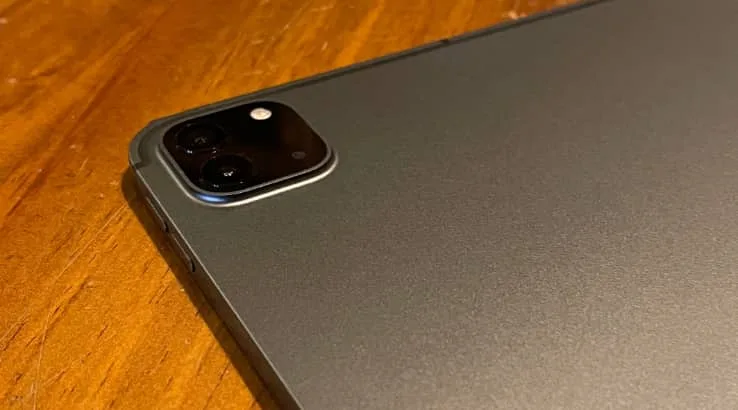
Taking photos on tablets has long been an awkward affair. For all the advantages of having a large viewfinder – and at 12.9 inches, you're not going to easily find one larger than the Apple iPad Pro M1 12.9 – you lose a lot in terms of comfortable placement and framing.
That's still true of the Apple iPad Pro M1 12.9 as a regular everyday camera, and it's clear that Apple leaves its best camera goodies for the iPhone 12 Pro Max. However, in tablet terms, the Apple iPad Pro M1 12.9 acquits itself fairly well as long as you understand its specific features and limitations.
At the rear, there's a dual-lens set-up with a 12MP wide and 10MP ultra-wide sensor along with a LIDAR scanner for depth-perception purposes. Apple's own camera app only gives you a few simple photo options, such as video at up to 4K/60fps, slow motion video at 240fps and standard still, square and panorama options. They work fairly well, but you will struggle to get the framing right as quickly as you might with a smaller smartphone camera.
Opt for Portrait mode, and you'll be instantly flipped around to the front-facing 12MP ultra-wide camera. Unlike with an iPhone, there's no capability for rear-facing portrait shots, with selfies your only option. Still, the front-facing camera is actually the most exciting part of the Apple iPad Pro M1 12.9, thanks to the new "Center Stage" feature.
The front-facing lens on the Apple iPad Pro M1 12.9 has a very wide 122° field of view, and it specifically uses this with machine learning to keep you in the frame even if you move around during a video call or video conference. It's an option for FaceTime calls, but Apple's made it an open software call that other apps can draw upon, including Zoom. The other advantage here is that it's smart enough to work out if other people come into the frame, adjusting its effective zoom range to take in multiple subjects. Yes, you can fool it if you move fast enough and really want to, but the point here is more to make it effortless to give presentations where you might need to move around a lot or hold meetings where one side of the call has multiple attendees without needing a camera zoomed out permanently or everyone crammed into a small lens space.
The downside of all that, naturally enough, is that it's going to be even harder to avoid being seen during Zoom meetings. Technology isn't always a positive force.
Performance
Performance
- M1 is insanely fast
- 5G capable – but not mmWave
- So much power, held back by iPadOS
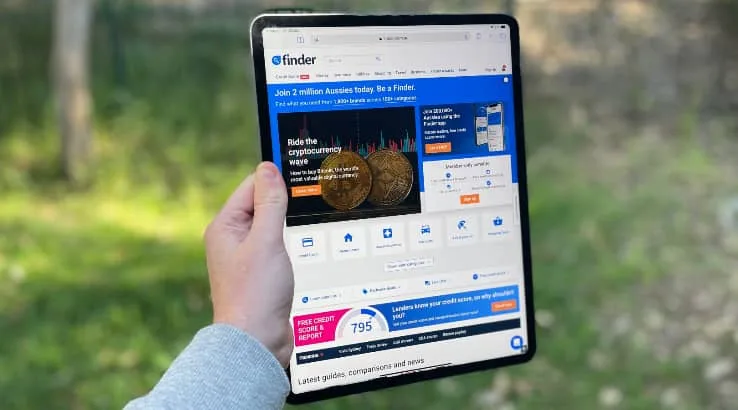
Where Apple has in years past opted for souped-up versions of its mobile A-series ARM-based processors to make its iPad Pro lines stand out, in 2021, it's gone down a different, but very predictable, path.
The Apple iPad Pro M1 12.9 runs on the M1 "Apple Silicon" system on a chip that Apple's already deployed for the new M1 MacBook Air, M1 MacBook Pro, M1 Mac Mini and M1 Apple iMac 24-inch.
It's not just the same family of chips; it's literally the same eight-core CPU and eight-core GPU M1 that's already shown its formidable strength in existing Mac lines, coming to the world of the iPad.
It almost feels as though Apple's just flexing its pecs at its tablet competitors at this point because last year's Apple iPad Pro wasn't exactly a slouch. But how do they compare against prior iPads and M1 Macs? Here's how it stacks up using Geekbench 5's CPU test:
The difference between the 2020 iPad Pro and the 2021 models isn't just some random 10% speed bump. It's a massive improvement in CPU performance, but it's worth putting into context against Apple's other professional-grade computer options.
Normally, I'd just compare iPads with other iPads, but the use of that common M1 SoC means that it's feasible – and quite appropriate – to compare it to Apple's other M1 lines.
That's especially true because of the Apple iPad Pro M1 12.9's pitch as a "Pro" level tablet and the price it commands as a result. You'd need to spend even more than the base price to get a keyboard – Apple has a version of its Magic Keyboard specifically for the new Apple iPad Pro M1 12.9 – but at that point, the performance line between it and a MacBook Pro M1 13 inch isn't considerable, at least on paper.
That does make the Apple iPad Pro M1 12.9 a serious professional tool in theory, but the application is where it becomes a little bit more challenging and that rests entirely on what iPadOS will currently allow you to do with an Apple iPad Pro M1 12.9.
You do get touch control, and it's compatible with the Apple Pencil for the artistic types, but you also get a significantly more constrained app environment relative to a "full" Mac, which could be yours for a very similar or lower price point, depending on what storage capacity you opt for. Apple sells the Apple iPad Pro M1 12.9 with up to a hefty 2TB of inbuilt storage but, as has long been the case, you'll pay a pretty premium for it.
It's also just simply the case that while there are specific professional grade applications such as Adobe Photoshop for iPad, giving it a definite workflow for in-the-field photographers working with HDR, there's also plenty more that aren't in play. Premiere Pro is nowhere to be seen, and it's even more surprising that Apple's own Final Cut Pro X hasn't made the leap to iPadOS yet either. There's a genuinely great rocket engine lurking under the display of the Apple iPad Pro M1 12.9, but it's arguably not quite there in terms of apps and multitasking in the same way that an M1 MacBook Pro absolutely is.
In connectivity terms, the new feature is the inclusion of inbuilt 5G, including via eSIM for added convenience. As it's done since the first iPad generation, you pay more for the SIM-enabled version of an iPad, but disappointingly, Apple's pulled the same trick it did with the iPhone 12 family with the new iPad Pro lines. In the US, iPad Pro models support both mmWave and sub-6Ghz 5G, but the models sold here are sub-6Ghz only. Given the recently concluded (at the time of writing) mmWave auction and announcements from telcos around live mmWave sites in Australia, it's annoying that Apple wasn't a little more forwards-looking in this respect. More likely is that the sub-6Ghz chips, which it still has to get from Qualcomm, are a little cheaper, and it can make more profit that way.
Battery life
Battery life
- 10-hour battery life remains achievable
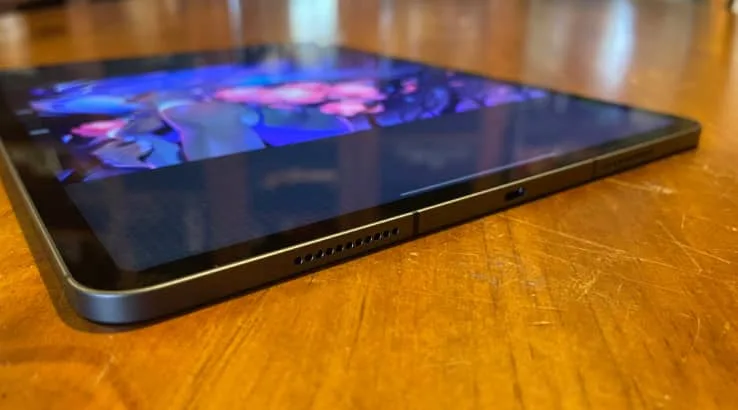
Apple has remained remarkably consistent with its battery life claims around iPads from day one. No matter the generation, no matter the underlying technology, what it's struck out for is a battery life of "up to" 10 hours between charges. Any figure listed as "up to" can of course vary and the use of features such as 5G will pull those figures downwards.
It's also an interesting contrast to the other battery-based M1 systems with similar-sized displays, where Apple claims up to 17 hours of battery life. There's a price to pay for all that Liquid Retina XDR goodness, I guess, because that's a fair bump down the timing scale.
Still, it's a fair figure, with my own tests during my review period pretty closely matching those figures most of the time. Throwing heavier duty apps at the Apple iPad Pro M1 12.9 will drain the battery more rapidly, but at least, unlike the iPhone, you do get a charger in the box.
Should you buy the Apple iPad Pro M1 12.9?
- Buy it if you want the fastest tablet on the market today with the nicest display.
- Don't buy it if you want full multitasking or an affordable option.
The Apple iPad Pro M1 12.9 is a remarkable tablet – remarkable in its power and remarkable in the quality of its Liquid Retina XDR display. It's even remarkable as a portable videoconferencing solution thanks to that Center Stage camera.
However, it's also remarkably expensive, especially if you kitted it out with the Apple Magic Keyboard, Apple Pencil and plenty of storage. The model as tested and supplied by Apple with those accessories would run you a whopping $4,098 or $3,549 just for the tablet itself. That's more expensive than the fully kitted-out MacBook Pro 13 with 2TB of internal storage all by itself.
If you're looking for something cheaper, we have also reviewed the new iPad Mini and 9th Generation iPad.
Pricing and availability
Specifications
General
Connectivity
Storage
Miscellaneous
Images: Alex Kidman
More Finder reviews
- Apple HomePod 2nd Gen review: Yes, it’s better
- Creality Ender-3 S1 Pro Review: Plenty of creative potential, but you’ll need patience too
- Apple Mac Mini M2 Pro review: A tale of two computers
- Apple MacBook Pro M2 Max 16-inch review: Next-level power
- HTC Vive XR Elite: Is this the perfect mix of Flow and Pro?



